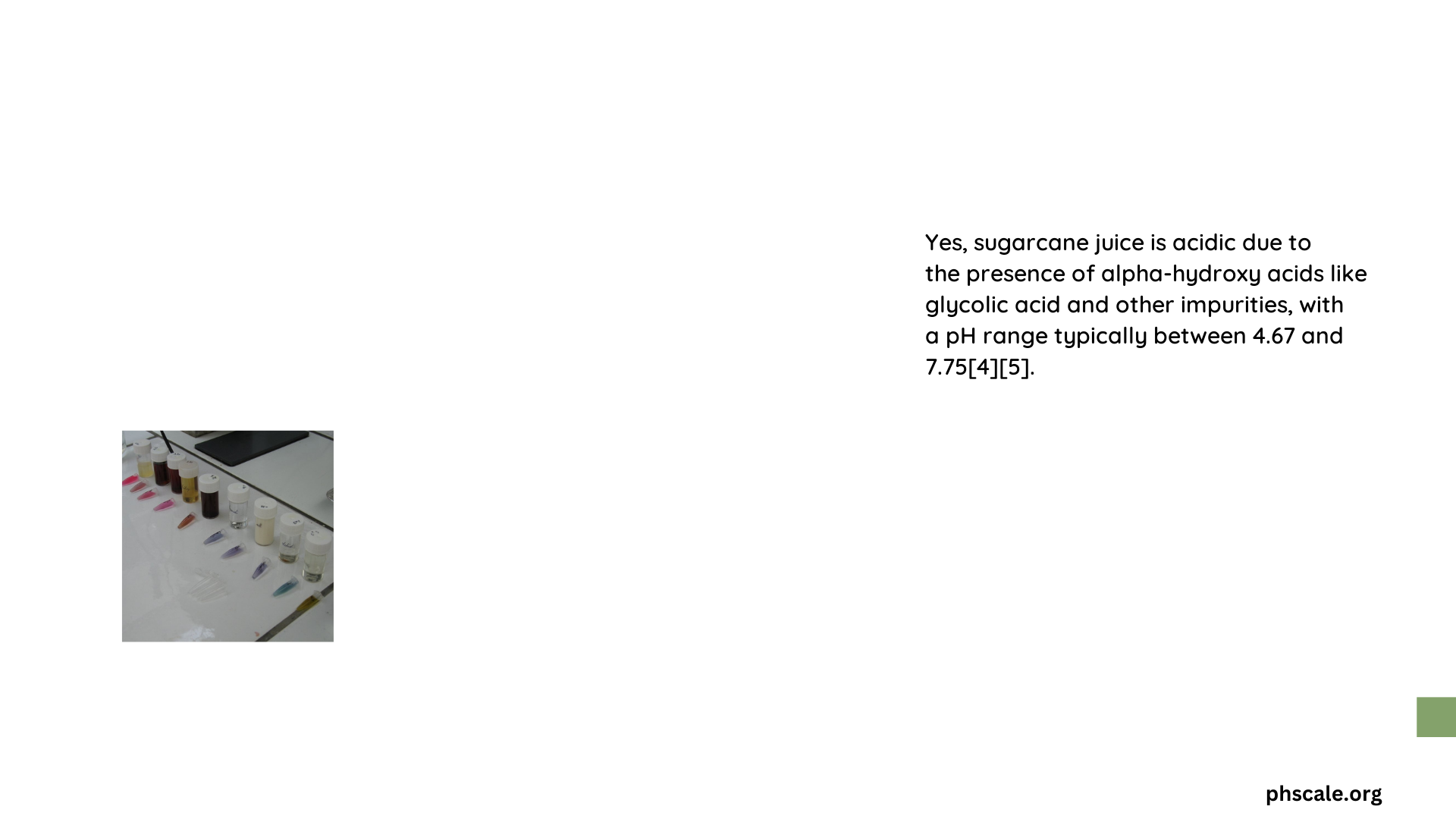Sugarcane juice, a popular natural beverage, is often questioned for its acidity. This article explores the pH level of sugarcane juice, its health implications, and nutritional facts. While sugarcane juice is indeed acidic, with a pH range of 4.5 to 5.5, it has unique properties that affect its interaction with the human body. Understanding its acidity is crucial for those with digestive concerns and for appreciating its overall health benefits.
What is the pH Level of Sugarcane Juice?
Sugarcane juice falls on the acidic side of the pH scale. Here’s a breakdown of its acidity:
- pH range: 4.5 to 5.5
- Specific studies have reported:
- pH values between 5.01 and 5.25
- pH range of 5.287 to 5.54
This places sugarcane juice in the mildly acidic category, similar to other fruit juices.
How Does the Acidity of Sugarcane Juice Compare to Other Beverages?

To put sugarcane juice’s acidity into perspective, let’s compare it with other common beverages:
| Beverage | pH Range |
|---|---|
| Sugarcane Juice | 4.5 – 5.5 |
| Orange Juice | 3.3 – 4.2 |
| Apple Juice | 3.3 – 4.0 |
| Coffee | 4.8 – 5.1 |
| Water | 7.0 |
As we can see, sugarcane juice is less acidic than many fruit juices but more acidic than water.
Does Sugarcane Juice’s Acidity Affect Digestive Health?
The acidity of sugarcane juice can have mixed effects on digestive health:
- Potential Benefits:
- Contains nutrients and antioxidants that may aid digestion
-
Has an alkalizing effect after metabolism, potentially balancing body pH
-
Potential Concerns:
- Initial acidity may exacerbate acid reflux or stomach ulcers
- Not recommended for those with severe acidity issues without medical consultation
It’s important to note that individual responses can vary, and moderation is key.
Can Sugarcane Juice Help with Acidity Issues?
Despite its initial acidity, some claim sugarcane juice can help with acidity issues. However:
- There’s no direct scientific evidence supporting this claim
- Its alkalizing effect post-metabolism might contribute to overall pH balance
- Individual responses can vary significantly
For those with acidity concerns, it’s advisable to:
– Consult a healthcare provider before regular consumption
– Monitor personal reactions to the juice
– Consider diluting the juice or consuming it with meals
What are the Nutritional Facts of Sugarcane Juice?
Understanding the nutritional profile of sugarcane juice is crucial:
- Sugar Content:
- High in sucrose
-
Sugar levels vary by cultivar and maturation stage
-
Soluble Solids:
-
Range from 14.13 to 18.60 ºBrix
-
Acidity Measures:
- pH: 4.5 to 5.5
-
Titratable acidity: 0.035 to 0.120% citric acid
-
Bioactive Compounds:
- Contains polyphenols
-
Enzymes like polyphenol oxidase and peroxidase present
-
Microbial Content:
- Fresh juice may contain mesophiles, psychrotrophs, molds, and yeasts
How Does the Acidity of Sugarcane Juice Change Over Time?
The acidity of sugarcane juice isn’t static and can change:
- Freshly Extracted:
- pH typically between 4.5 to 5.5
-
Lowest acidity immediately after extraction
-
Over Time:
- Acidity may increase due to fermentation
-
Microbial activity can lead to pH decrease
-
Processing Effects:
- Heat treatment can slightly alter pH
- Preservation methods may stabilize acidity
What Factors Influence the Acidity of Sugarcane Juice?
Several factors can affect the acidity of sugarcane juice:
- Sugarcane Variety:
-
Different cultivars have varying acid content
-
Harvesting Time:
-
Maturity of the cane affects acid levels
-
Extraction Method:
-
Mechanical vs. manual extraction can influence pH
-
Storage Conditions:
-
Temperature and duration affect acidity changes
-
Additives:
- Preservatives or flavorings may alter pH
Understanding these factors helps in managing the juice’s acidity for both production and consumption purposes.
Are There Any Health Benefits Despite Sugarcane Juice’s Acidity?
While sugarcane juice is acidic, it offers several health benefits:
- Rich in Antioxidants: Helps combat oxidative stress
- Hydration: Natural electrolytes aid in hydration
- Energy Boost: Natural sugars provide quick energy
- Nutrient Source: Contains vitamins and minerals
However, these benefits should be weighed against individual health conditions, especially for those with acidity-related issues.
How Should Sugarcane Juice be Consumed Considering Its Acidity?
To maximize benefits and minimize potential issues related to its acidity:
- Moderation: Consume in reasonable quantities
- Timing: Best consumed between meals rather than on an empty stomach
- Dilution: Can be mixed with water to reduce acidity
- Freshness: Consume immediately after extraction when possible
- Accompaniments: Pairing with alkaline foods may help balance acidity
By following these guidelines, one can enjoy sugarcane juice while managing its acidic nature.
References:
1. https://www.scielo.br/j/cta/a/prT86Kkykgf84vyj88MWf7z/?format=pdf&lang=en
2. https://sensorex.com/sugar-processing/
3. https://www.tandfonline.com/doi/pdf/10.1081/JFP-120015603
